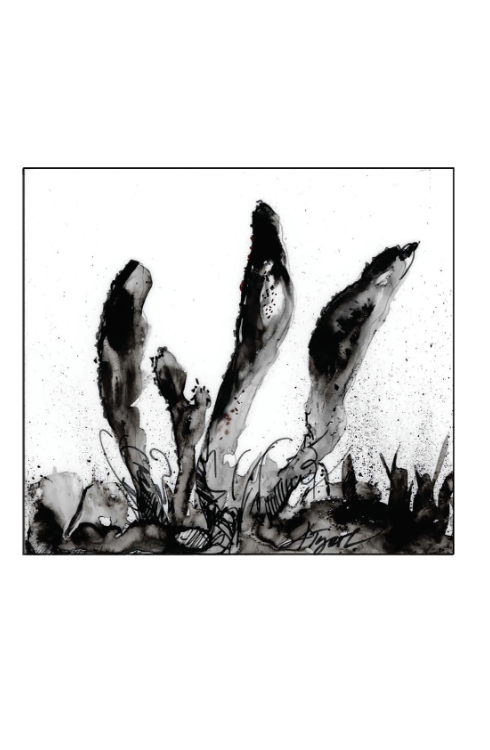By Rachel Sargent Mirus
“Look!” I exclaimed, bending to examine a pair of half-inch-tall, bright orange, club-shaped mushrooms. Kneeling in the leaf litter, with my 2-year-old son watching in puzzlement, I carefully scraped away at the base of the colorful clubs. Just beneath the soil was a glossy brown moth pupa: the origin of the mushrooms’ stalks.
This is the orange caterpillar club (Cordyceps militaris), an insect-eating fungus that is easy to find, if you know what to look for. Naturalists have studied this species for centuries; its formal scientific description was written in 1753 by Carl Linnaeus, the scientist famous for formalizing the system of Latin names researchers use to categorize species. Its mushrooms are small, often 1 to two inches tall, or even smaller, and they’re also neon orange and common in the Northeast. Each mushroom is shaped like a slender, elongated club. If you look closely, the head of the club is finely speckled with dark orange “perithecia.” These are hollow, pear-shaped organs with a pore at the top that make the mushrooms’ spores.
The orange caterpillar club fungus is one example of the 400 to 500 closely related species that are collectively known as cordyceps fungi. Most of the fungi in this group parasitize insects or other types of arthropods, but a few are parasites of different fungi. The orange caterpillar club, as its common name suggests, primarily parasitizes moth and butterfly species that pupate underground.
I tend to find orange caterpillar club fungi poking up from less-traveled forest trails during late summer and fall. What makes these mushrooms so much fun to spot is the story behind their appearance. While entomologists and mycologists are still piecing that story together, they currently think it starts when a caterpillar club spore, carried on the breeze, lands on the skin of a host caterpillar. Once there, it germinates, breaches the insect’s cuticle, and grows into a fungus. After the caterpillar has pupated, that fungus slowly consumes the pupa from the inside, eventually becoming big enough to push an orange club mushroom up through the soil and release more spores, starting the story anew.
A number of moth species in the Northeast have larvae that burrow into the soil to pupate, and this fungus isn’t picky about potential hosts. A 2016 study found that Cordyceps militaris would parasitize at least 32 different insect species, including moths, butterflies, and beetles. I’ve found these mushrooms growing out of pupae ranging in size from 3/4 of an inch to 2 inches. The largest pupa I found also boasted by far the largest orange club, which was more than 2 inches tall.
Mushroom cultivators have begun growing Cordyceps militaris because of its potential medicinal value. It is related to Ophiocordyceps sinensis, a species that is used in traditional Chinese treatments. Possible anti-cancer, anti-inflammatory, anti-biotic, neuroprotective, immune, and fertility benefits have been attributed to these fungi, although scientific research into their properties is ongoing. While the orange caterpillar club fungus requires a pupal host in the wild, cultivators can grow it on food sources manufactured from brown rice and a careful balance of nutrients. Grown under these conditions, the mushrooms become a tangled mass of orange spikes, very different in appearance from the one or two clubs that pop up in the woods.
Fungi that specialize in living on, and eventually killing, insect hosts are collectively called “entomopathogenic.” These types of fungi can target many kinds of arthropods and are sometimes used for pest control. Researchers are studying the potential for some species as a biocontrol option for ticks, while others are used in biopesticides to limit plant-eating insects, including aphids, thrips, and grasshoppers. Entomopathogenic fungi have even been investigated as a way to keep honeybee pests, such as the Varroa mite, in check. The easy-to-spot, brightly colored mushrooms of the orange caterpillar club fungus are visible eruptions of an unseen contest between arthropods and entomopathogenic fungi.
The woods are full of such hidden stories. Some of them, like a cordyceps mushroom, are easy to step right past. But if you spot an orange nub sticking up from the leaf litter, dig down a bit, and you just might find a moth pupa.
Rachel Sargent Mirus is a teaching artist and writer. Illustration by Adelaide Murphy Tyrol. The Outside Story is assigned and edited by Northern Woodlands magazine and sponsored by the Wellborn Ecology Fund of the New Hampshire Charitable Foundation:.nhcf.org.





